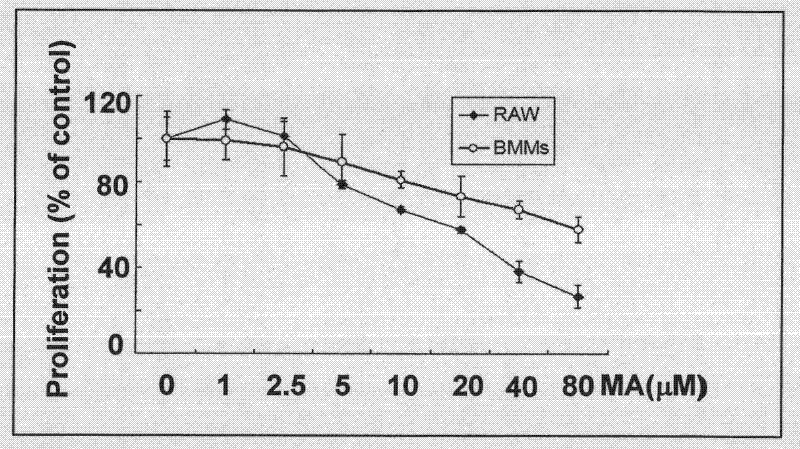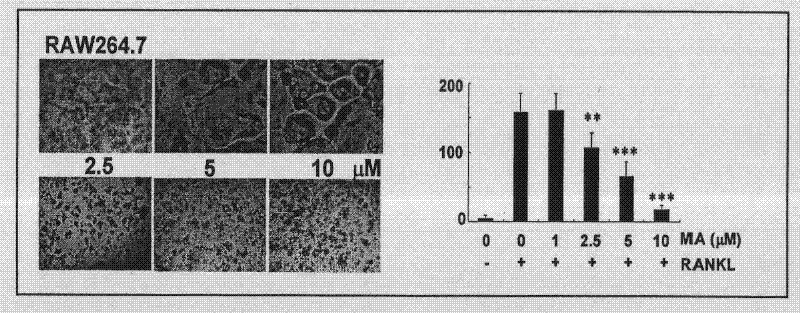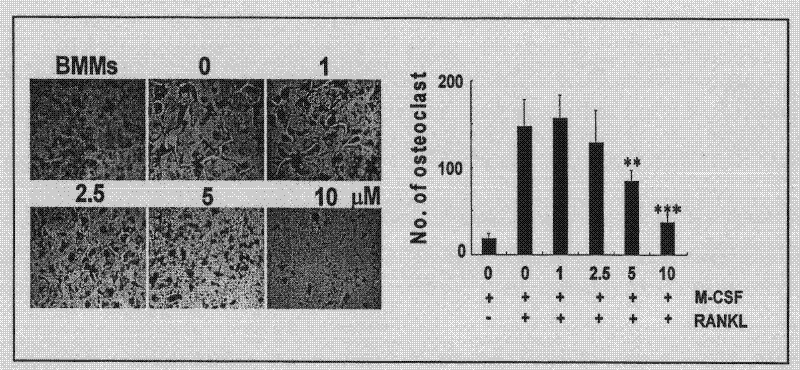Use of crataegolic acid and derivatives thereof in preparation of therapeutic and/or preventive medicines for inhibiting osteoclast differentiation and function
A technology for inhibiting osteoclast and cell differentiation, which is applied in the application field of maslinic acid and its derivatives in the preparation of therapeutic and/or preventive medicines for inhibiting the differentiation and function of osteoclasts, and can solve the problem that no maslinic acid inhibits osteoclast differentiation. and function, no maslinic acid osteoporosis drug and other issues
- Summary
- Abstract
- Description
- Claims
- Application Information
AI Technical Summary
Problems solved by technology
Method used
Image
Examples
Embodiment 1
[0021] Embodiment 1: cytotoxicity test
[0022] Experimental principle: In living cells, NADPH dehydrogenase in mitochondria converts MTS tetrazolium salt into a colored substance soluble in cell culture fluid. The more living cells, the more colored salts will be produced. Therefore, under certain conditions, the number of living cells is directly proportional to the amount of the substance produced. Therefore, the number of living cells can be indirectly reflected by detecting the absorption value of the substance at 490nm. This method can be used to evaluate the effect of drugs on the proliferation ability of cells.
[0023] Methods: Osteoclast precursor cells were inoculated into 96-well culture plate, 3000 cells / well, and control group and drug-dosed group were set up. When the cells are attached to the wall, add different concentrations of drugs for treatment. After 72 hours, add 20 microliters of cellTiter96 Aqueous cell proliferation detection reagent, incubate for 1...
Embodiment 2
[0025] Example 2: Maslinic acid inhibits differentiation of osteoclast precursor cells
[0026] Principle: Under the induction of differentiation cytokines (such as RANKL, M-CSF), mononuclear osteoclast precursor cells can gradually fuse and differentiate into multinucleated mature osteoclasts. Osteoclast precursor cells do not have the ability to dissolve osteolysis, only differentiated mature osteoclasts have the ability to dissolve stubborn cells, therefore, the differentiation level of osteoclasts can reflect their osteolytic ability.
[0027] Methods: Osteoclast precursor cell lines or primary isolated and cultured mouse osteoclast precursor cells were inoculated into 48-well culture plates, 3000 cells / well. Set up a control group, a single-dosing group and a double-dosing group. After the cells adhered to the wall overnight, different doses of maslinic acid and / or 50 ng / ml RANKL were added, and the culture continued for 3 to 5 days. After the cells with single addition...
Embodiment 3
[0029] Example 3: Maslinic acid inhibits osteoclast bone resorption test (pits assay)
[0030] Principle: Mature osteoclasts can dissolve and resorb bone, leaving imprints on the surface of bone. The degree of damage to the bone surface directly reflects the ability of osteoclasts to resorb bone. The principle of this experiment is to use this feature to differentiate osteoclast precursors on the surface of bone slices, and to detect and analyze the ability of these differentiated cells to dissolve bone slices.
[0031]Method: Osteoclasts were inoculated on the bone slices placed in a 48-well plate (3000 / piece / well). After the cells adhered to the wall overnight, different doses of maslinic acid and 50ng / ml RANKL were added to induce cell differentiation. control group. After 3 to 4 days, wait until the cells in the RANKL group are fully differentiated and mature into multinucleated cells, and after another 6 to 12 hours, remove the cells on the surface of the bone slices, s...
PUM
 Login to View More
Login to View More Abstract
Description
Claims
Application Information
 Login to View More
Login to View More - R&D
- Intellectual Property
- Life Sciences
- Materials
- Tech Scout
- Unparalleled Data Quality
- Higher Quality Content
- 60% Fewer Hallucinations
Browse by: Latest US Patents, China's latest patents, Technical Efficacy Thesaurus, Application Domain, Technology Topic, Popular Technical Reports.
© 2025 PatSnap. All rights reserved.Legal|Privacy policy|Modern Slavery Act Transparency Statement|Sitemap|About US| Contact US: help@patsnap.com



